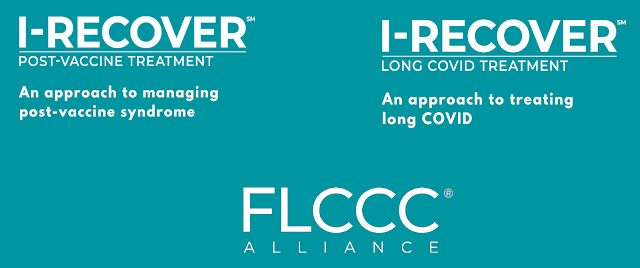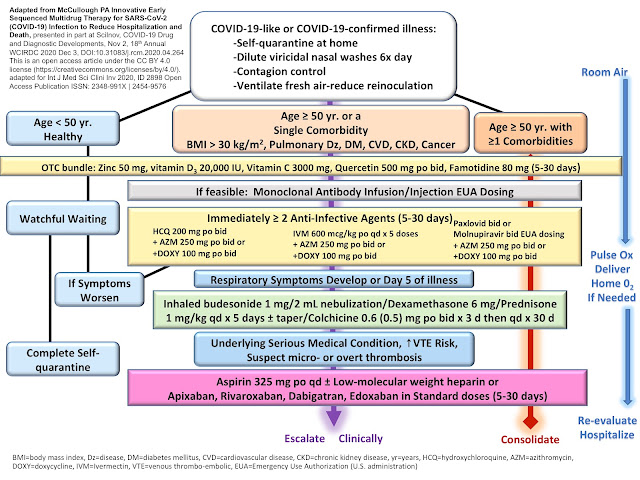FLCCC I-CARE COVID Treatment Protocol for Outpatients (2025 Edition)
About I-CARE Protocol
The information in this document is our recommended approach to COVID-19 based on the best (and most recent) literature. It is provided as guidance to healthcare providers worldwide on the early treatment of COVID-19. Patients should always consult with their provider before starting any medical treatment.- The Stratus Variant (XFG): Symptoms, Global Spread, and Impact in Late 2025
- Note: According to Dr Pierre Kory, "...highlighting his objectivity, while Pierre Kory was once the leading advocate for ivermectin to treat COVID, he no longer does as the newer variants don’t respond to it (whereas vaccine injuries do because the vaccines used the original spike protein." (A Midwestern Doctor 2025)
- Methylene blue
- Curcumin
- Nigella Sativa
- Selective Serotonin Reuptake Inhibitors (SSRIs)
Note that there are two I-Care Protocols; the I-Care Covid protocol (this article) to treat Covid and another protocol, I-Care Flu protocol; to treat influenza and RSV infections.
- The I-Care protocol has been updated and below is their latest version (December 2024).
- Short-term use of fluvoxamine to second line treatments was added with the April 2024 update.
 |
| McCullough et al. Reviews in Cardiovascular Medicine, 2020 |
First Line Therapies
(In order of priority; not all required.)- Mouthwash: 3 times a day. Gargle three times a day (do not swallow) with an antiseptic-antimicrobial mouthwash containing chlorhexidine, cetylpyridinium chloride (e.g., Scope™, Act™, Crest™), or 1% povidone-iodine (Immune Mist™).
- Nasal spray with 1% povidone-iodine (Immune Mist™): 2-3 times a day. Do not use for more than 5 days in pregnancy. If 1% product is not available, dilute the more widely available 10% solution (see box) and apply 4-5 drops to each nostril every 4 hours.
- Pour 1 ½ tablespoons (25 ml) of 10% povidone-iodine solution into a 250 ml nasal irrigation bottle.
- Fill bottle to top with distilled, sterile, or previously boiled water.
- To use: tilt head back, apply 4-5 drops to each nostril. Keep head tilted for a few minutes, then let drain.
- Ivermectin: 0.4 to 0.6 mg/kg – one dose daily for at least 5 days or until symptoms resolve. If symptoms persist longer than 5 days, consult a healthcare provider. See Table 1 (below) for help with calculating correct dose. Due to a possible interaction between quercetin and ivermectin, these drugs should be staggered throughout the day (see Table 2 below). For COVID treatment, ivermectin is best taken with a meal or just following a meal, for greater absorption. (Meta Analysis 2025)
- Hydroxychloroquine (HCQ): 200 mg twice a day for 5 to 10 days. Best taken with zinc. HCQ may be taken in place of, or together with, ivermectin. While ivermectin should be avoided in pregnancy, the FDA considers HCQ safe in pregnancy. Given the pathway used by the Omicron variant to gain cell entry, HCQ may be the preferred drug for this variant.
- Vitamin D3: For patients with acute COVID-19 infection, calcifediol as dosed in table below is suggested.
- Quercetin (or a mixed flavonoid supplement): 250-500 mg twice a day. Due to a possible interaction between quercetin and ivermectin, these drugs should not be taken simultaneously (i.e., should be staggered at different times of day.) As supplemental quercetin has poor solubility and low oral absorption, lecithin-based and nanoparticle formulations are preferred.
- Nigella sativa (Black Seed Oil): If using seeds, take 80 mg/kg once a day (or 400 to 500 mg of encapsulated oil twice a day).
- Melatonin: 5-10 mg before bedtime (causes drowsiness). Slow- or extended-release formulations preferred.
- Curcumin (turmeric): 500 mg twice a day. Curcumin has low solubility in water and is poorly absorbed by the body; consequently, it is traditionally taken with full fat milk and black pepper, which enhance its absorption.
- Zinc: 75-100 mg daily. Take with HCQ (above). Zinc supplements come in various forms (e.g., zinc sulfate, zinc citrate and zinc gluconate).
- Probenecid: 1000 mg twice daily for five days.
- Aspirin: 325 mg daily (unless contraindicated).
- Metformin: 500 mg on day 1, 500 mg twice daily on days 2 through 5, then 500 mg in the morning and 1000 mg in the evening up to day 14. (RECOVER 2024, The Lancet 2023, COVID-OUT: NEJM 2022)
- Kefir and/or Bifidobacterium Probiotics. Depending on the brand, these products can be very high in sugar, which promotes inflammation. Look for brands without added sugar or fruit jellies and choose products with more than one strain of lactobacillus and bifidobacteria. Try to choose probiotics that are also gluten-free, casein-free and soy-free.
- Vitamin C: 500-1000 mg twice a day. (Alternatively, take one to two servings a day of your local organic fruits)
- Honey: 1 g/kg one to two times a day.
- Home pulse oximeter. Monitoring of oxygen saturation is recommended in symptomatic patients, due to asymptomatic hypoxia. Take multiple readings over the course of the day and regard any downward trend as ominous. Baseline or ambulatory desaturation under 94% should prompt consultation with primary or telehealth provider, or evaluation in an emergency room. (See box for further guidance.)
- Only accept values associated with a strong pulse signal
- Observe readings for 30–60 seconds to identify the most common value
- Warm up extremities prior to taking a measurement
- Use the middle or ring finger
- Remove nail polish from the finger on which measurements are made
- If ivermectin is unavailable, mebendazole—another anti-parasitic medication—may be considered as an alternative option (Pharmaceuticals 2023).
- Please note that chronic use of Listerine™ increases fusobacterium in the oral and gut microbiome. (source) Fusobacterium is associated with many cancer including colorectal, breast, oral, etc. (source) We there suggest that Listerine be used for short term use.
Treatment of Current Circulating variants and sub-variants
That doesn’t mean you shouldn’t take steps to protect yourself. The good news is that the advice we’ve been sharing from the FLCCC all along still stands — do what you can to prevent getting ill and if you do get it, treat immediately. Early treatment is critical.
- The combination of both HCQ and ivermectin
- Nattokinase 2000-4000 FU/day for 15 days OR Apixaban 5 mg daily for 15 days OR Rivaroxaban 10 mg daily for 15 days. The escalated use of anticoagulants should only be considered in patients with a low risk of bleeding. Furthermore, the risk of serious bleeding increases as the number of anticoagulant drugs is increased.
- Spironolactone: 200 mg once daily for 7 days (avoid in patients with impaired renal function)
Hypoxia/shortness of breath: If the patients develop hypoxia or shortness of breath Prednisolone 60 mg daily for 5 days should be prescribed.
Second Line Therapies
(In order of priority/importance.)
- Nitazoxanide (NTZ): 500 mg twice a day for 5 days.
- Lactoferrin: 100-400 mg daily
- Diphenhydramine (Benadryl): 25-50 mg every 6 hours
- B complex vitamins.
- Fluvoxamine: 25-50 mg twice a day for 1 week. NOTE: Due to serious risks of acute anxiety that may progress to mania or suicidal/violent behavior, this drug should not be prescribed for COVID for longer than two weeks.
- N-acetyl cysteine (NAC): 600-1200 mg orally twice a day.
- Omega-3 fatty acids: 4 g daily. Vascepa (Ethyl eicosapentaenoic acid); Lovaza (EPA/DHA); or alternative DHA/EPA. Vascepa and Lovaza tablets must be swallowed and cannot be crushed, dissolved, or chewed.
About Ivermectin
To review the totality of supporting evidence for ivermectin in COVID-19, visit our Ivermectin information page.
Ivermectin is a remarkably safe drug with minimal adverse reactions (almost all minor), however its safety in pregnancy has not been definitively established. Talk to your doctor about use in pregnancy, particularly in the first trimester.Potential drug-drug interactions should be reviewed before prescribing ivermectin.
Ivermectin has been demonstrated to be highly effective against the Omicron variant at a dose of 0.3 to 0.4 mg/kg, when taken early.
Table 1. How to calculate ivermectin dose
Note that ivermectin is available in different strengths (e.g., 3, 6 or 12 mg) and administration forms (tablets, capsules, drops, etc.). Note that tablets can be halved for more accurate dosing, while capsules cannot. |
| Ivermectin: Calculation of correct dose |
Ordinary Vitamin D3 Does not work in Acute Illness
FLCCC/IMA protocols
To find a list of physicians who follow the protocols and provide in-office and telehealth services: List of Doctors that will prescribe I-Care Protocol.Ivermectin - Nobel Prize Winning Medication
 |
| Buy on The Wellness Company |
✔ Convenient 6-Month Supply (18 mg each)
✔ FDA-Approved Medication
✔ Doctor-Prescribed




.png)


.png)


What are the possible interactions of quercetin and ivermectin? I have done a brief search and can’t find anything. Thank you.
ReplyDelete